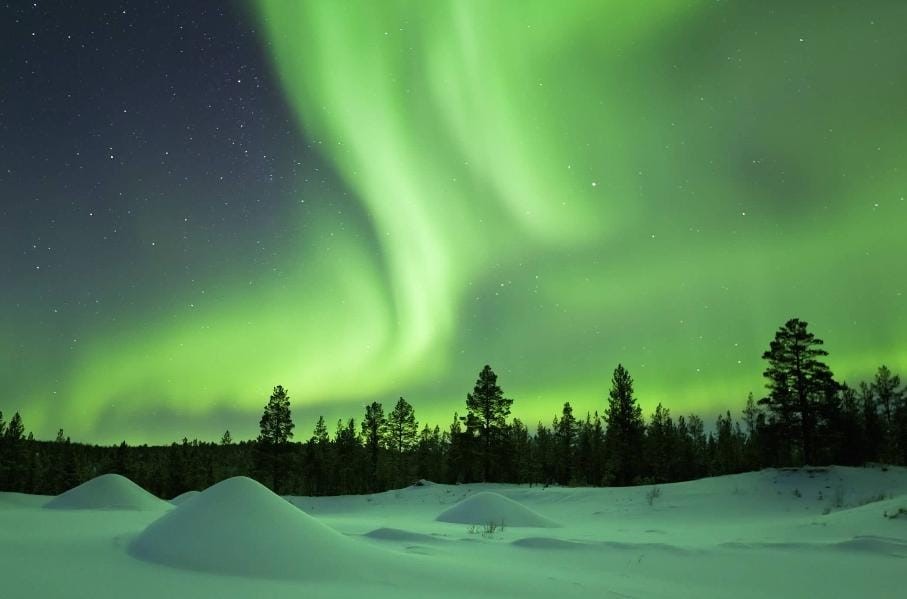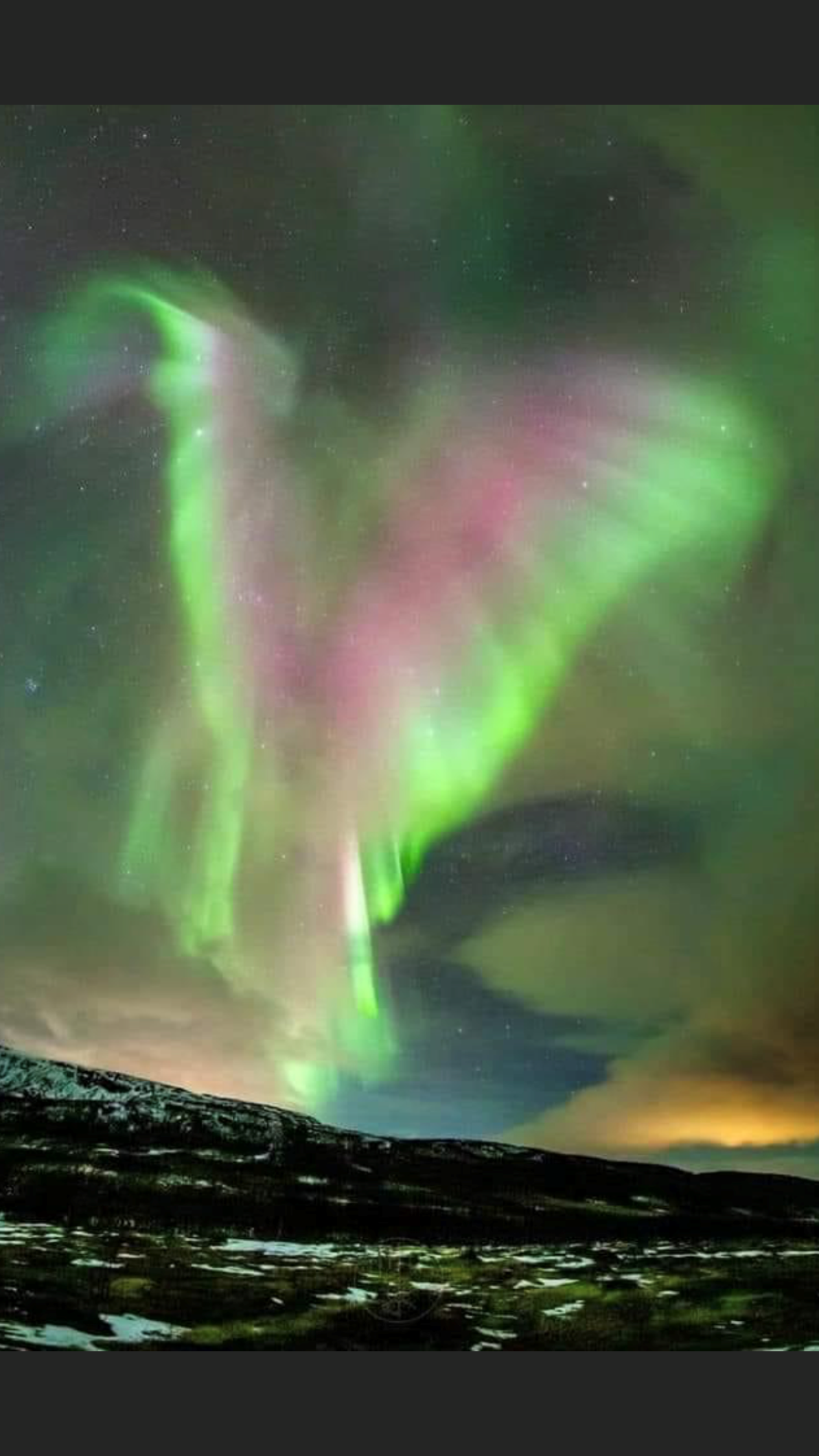What are the northern (polar) lights?
by
Robert Gorter, MD, PhD, and Gurwant Brar et al.
December 25 2020

The northern lights, one of several astronomical phenomena called polar lights (aurora polaris), are shafts or curtains of colored light visible on occasion in the night sky.
Polar lights (aurora polaris) are a natural phenomenon found in both the northern and southern hemispheres that can be truly awe inspiring. Northern lights are also called by their scientific name, aurora borealis, and southern lights are called aurora australis.
Sten Odenwald, author of The 23rd Cycle: learning to live with a stormy star (New York, Columbia University Press, c2001), provides insight into how northern lights are generated:

The origin of the aurora begins on the surface of the sun when solar activity ejects a cloud of gas and highly charged particles. Scientists call this a coronal mass ejection (CME). If one of these reaches earth, taking about 2 to 3 days, it collides with the Earth’s magnetic field. This field is invisible, and if you could see its shape, it would make Earth look like a comet with a long magnetic ‘tail’ stretching a million miles behind Earth in the opposite direction of the sun.
When a coronal mass ejection collides with the magnetic field, it causes complex changes to happen to the magnetic tail region. These changes generate currents of charged particles, which then flow along lines of magnetic force into the Polar Regions. These particles are boosted in energy in Earth’s upper atmosphere, and when they collide with oxygen and nitrogen atoms, they produce dazzling auroral light.
Odenwald further tells us “Auroras are beautiful, but the invisible flows of particles and magnetism that go on at the same time can damage our electrical power grid and satellites operating in space. This is why scientists are so keen to understand the physics of aurora and solar storms, so we can predict when our technologies may be affected.”
Dr. Gorter: in addition, these magnetic fields around the earth protect life on earth against cosmic radiation which would otherwise kill all plant and animal life on earth. Thus; nature needs this protection like also the ozone layer around the earth. The ozone layer is also part of our protection. Propellants damage the ozone layer. 5G pinches hole into the magnetic fields around the earth and will eventually damage and weaken its protective effect.
Can I see them anywhere?
Yes, although they are more frequent at higher latitudes and places like Alaska, Canada, Scandinavia and Antarctica, closer to the Earth’s poles. Occasionally, they have been seen closer to the equator, and even as far south as Mexico. To view them, look in the direction of the closest pole (the northern horizon in the northern hemisphere, the southern horizon in the southern hemisphere).
Can I see them at any time of the year?
Yes. In some areas, such as Alaska or Greenland, they may be visible most nights of the year. And they occur at any time of the day, but we can’t see them with the naked eye unless it’s dark.
What causes the colors and patterns?
Colors and patterns are from the types of ions or atoms being energized as they collide with the atmosphere and are affected by lines of magnetic force. Displays may take many forms, including rippling curtains, pulsating globs, traveling pulses, or steady glows. Altitude affects the colors. Blue violet/reds occur below 60 miles (100 km), with bright green strongest between 60-150 miles (100-240 km). Above 150 miles (240 km) ruby reds appear.
Related Websites
The Aurora Page External (Michigan Technical Institute) – Includes images and links.
Auroras: Paintings in the Sky External (Exploratorium) – Lots of links, pictures, includes specific information for teachers.
Solar Storms External (Solar Storms.org) – This site presents information about the human impacts of solar storms and space weather.
Space Weather Research Explorer: Auroras External (Exploratorium) – With data from POES, this site packages the information in a simpler format.
Space Weather Prediction Center (NOAA) – Describes the auroras, and why they occur.
What is an aurora? (NASA Space Place)
Further Reading
Berry, Janice. Aurora borealis: a photo memory. Anchorage, AK, Todd Communications, c1999. 64 p.
Bone, Neil. The aurora: sun-earth interactions. 2nd ed. Chichester, NY, Wiley, 1996. 172 p.
Kalz, Jill. Northern lights. Mankato, MN, Creative Education, 2004. 32 p. (Juvenile literature)
Kelley, David H., and Eugene F. Milone. Exploring ancient skies: an encyclopedic survey of archaeoastronomy. New York, Springer, c2005. 612 p.
Silverman, S. M. “Comparison of the aurora of September 1/2, 1859 with other great auroras.” Advances in space research, v. 38, no. 2, 2006: 136-144.
Odenwald, Sten. The 23rd cycle: learning to live with a stormy star. New York, Columbia University Press, c2001. 207 p.
Northern lights. Minneapolis, Carolrhoda Books, c1994. 48 p. (Juvenile literature)
Stephenson, F. Richard, David M. Willis, and Thomas J. Hallinan. “The earliest datable observation of the aurora borealis.” Astronomy & geophysics, v. 45, Dec. 2004: 6.15-6.17.
Taylor, Kenny. “Auroras: Earth’s grand show of lights.” National geographic, v. 200, Nov. 2001: 48-63.
Wright, Karen. “Seeing the light.” Discover, v. 21, July 2000: 50-56.
Brekke, Asgeir, and Alv Egeland. The northern lights: their heritage and science. Translated by James Anderson. Oslo, Grøndahl Dreyer, c1994. 168 p.
Cowen, Robert C. “How northern lights affect your local power and light.” Christian science monitor, v. 88, May 29, 1996: 3.
Davis, T. Neil. The aurora watcher’s handbook. Fairbanks, University of Alaska Press, 1992. 230 p.
Eather, Robert H. Majestic lights, the aurora in science, history, and the arts. Washington, American Geophysical Union, c1980. 323 p.
Falck-Ytter, Harald. Aurora: the northern lights in mythology, history, and science. photographs by Torbjörn Lövgren ; [translated by Robin Alexander]. Edinburgh, Floris, 1985. 143 p.
Green, James L., and others. “Eyewitness reports of the great auroral storm of 1859.” Advances in space research, v. 38, no. 2, 2006: 145-154.
Harrison, Giles. “Aurora diaries.” Astronomy & geophysics, v. 46, Aug. 2005: 4.31-4.34.
Jago, Lucy. The northern lights; the true story of the man who unlocked the secrets of the aurora borealis. New York, Knopf, 2001. 297 p.